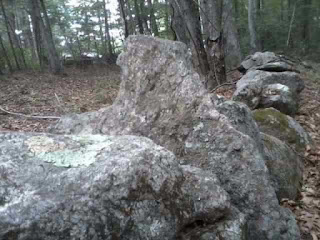Special Cairn Field & StoneWorks Site Pt 4- StoneWall Features of An Obvious Native Origin
I would just like to say a final word about the cairns themselves to wrap up the last post. There are at least several cairns that have not been cleared, some of which I identified were even under the top soil. I have no intention of clearing around these cairns. I only cleared around the ones whose top stones could be seen poking out with the naked eye, and sometimes a cairn was revealed by general forest clearing when I was pulling up saplings, thornes & cutting down overgrowth of young trees. May be by collaborating with researchers in the future a closer look at these yet unrevealed cairns could help with the general research of this site.
We will now focus our attention on some of the stone-wall features which should reveal non-debatable, un-deniable proof that these walls are of an indigenous origin. Curt Hoffman was impressed and took note of some of these features. Once research into these sites takes off by the individual a clear difference in many cases can usually be distinguished between a colonial or later wall and a wall of indigenous origin- I have described some of these details before throughout this blog.
In the book Manitou by Mavor and Dix on page 17 they talked about an excavation around a stone wall in Vermont that revealed a green layer of soil that geologists indpendantly analyzed who "were of the opinion that it was either the first soil laid down after the recession of the last glacial age or the soil remaining from an interglacial period BEFORE the last glaciation. This astounding result implies antiquity of at least 10,000 years for material in the undisturbed green layer". (from Manitou by Mavor & Dix pg. 17- my emphasis on the capital letters was stressed.) Acknowledging and giving proper due credit to these findings would re-establish history as we know it, in this case specifically pertaining to Native people of the NorthEast.
So let's get right into some of the interesting StoneWall features associated with this site. First we have a perched stone effigy in the form of a bird's head:
I apologize for the crappy quality on this picture (try tracing the stone w/ the computer mouse). Here we are looking at a Standing Stone (which in length is about up to one's knee) that has been propped up by the side of the stone wall. The top of the standing stone slightly curves to the left and has been notched/ marked out. This feature is also in a vertical alignment with the stone marker on top of the cairn featured in part 2, which had the solar alignment:
Directly above the Standing Stone is this "head and shoulders"-like Manitou stone that has been distingiushably inserted vertically among the stones in the wall. This Manitou stone also displays a beak and appears to be a bird effigy, may be even a thunderbird of great power:
View B of the Manitou Bird Effigy:
Moving along the wall we come to this curious feature, which is a break in the wall. There is a stone step on the lower level with a chink in it that one can perfectly place their heel into while stepping up/ down this small break in the wall. On the other side of the wall is a propped boulder one can walk up to which can be perfectly seen through the break in the wall:
Very interesting propped stone and stone placements in the wall. Sitting on top of the propped stone is a triangular stone which appears to be some kind of focal/ meditative point (for instance if you were sitting down staring at it). I have shown the same kind of triangular stones in walls before at other sites shown in this blog, one of which appears directly outside an underground room I chronicled last month:
A turtle effigy in the wall or perhaps even an anthropamorphized "turtle man". On the neighboring land behind the wall is a ledge that Curt Hoffman was very keen to take note of:
Two quartz balls hanging out at the base of a stone:
What looks like an altar/ small enclosure in the wall. The altar, or stone slab has an exposed quartz vein running down the length of it:
View of one of the sides of the stone wall:
Another Standing Stone found associated with this wall. This was found knocked over and I simply stood it up where I found it. This is nicely worked out:
Here I show a crescent-shaped stone idol that was found next to the standing stone in the above pic:
Another crescent shaped stone idol, bird-like, with burn marks on the base of the stone, indicating it's use in ceremony:
Rounded stone propped up on the wall. A bear's head? Deer's head? Or is that a worn-out moss-covered etching of a snake in the stone?:
Stone slab in the wall with a stone point underneath the middle of the slab:
Another view of stone-wall section:
Part 5 will concentrate on a propped boulder frog effigy above a vernal pool, and a stone bench dolmen next to the vernal pool which should wrap things up for this site.
















No comments:
Post a Comment